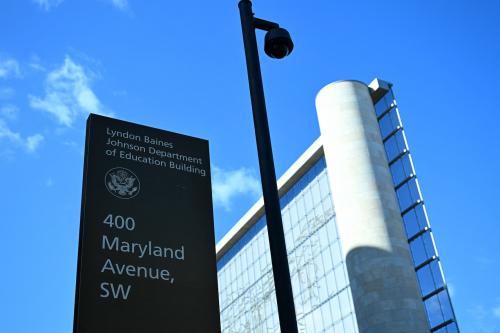Unarmed black males continue to be disproportionately victimized by police violence in America. A sequence of recent high-profile shootings has sparked a national conversation on the treatment and perceived value of black males, as well as the legitimacy of lethal force by police. Many have questioned whether black males receive the same protections under the law or the same guarantee of the right to life and security as other individuals.
On October 26, the Race, Prosperity, and Inclusion Initiative at Brookings hosted a moderated discussion with legal, academic, and advocacy experts to examine these pressing issues and explore policy options to address the cycle of excessive police force against black males.
The statistics explaining the use of deadly force in America
Kwadwo Frimpong, a senior research analyst in the Race, Prosperity, and Inclusion Initiative, began the event by presenting statistics on police violence. He noted that black males are killed by police officers at three times their relative share of the national population, and are twice as likely to be killed by a police officer as a white male. “Clearly, there is evidence of a racial disparity in the use of lethal force by law enforcement,” he said.
Supreme Court rulings and the effect on policing
Moderator Camille Busette, senior fellow and the director of the Race, Prosperity, and Inclusion Initiative, started the panel with a discussion of Supreme Court rulings that have set the stage for the prevalent use of deadly force by police officers. Busette and the panelists explained the implications of Tennessee v. Garner, which ruled that an officer may, with probable cause, use deadly force against a fleeing suspect, and Graham v. Connor, which ruled that an objective reasonableness standard should be used when determining whether an officer displayed excessive force.
Dr. Rashawn Ray, an associate professor of sociology at the University of Maryland, noted that there had been a steady decrease in police shootings until the late 1990s, when the use of deadly force began to increase again. Contrary to popular opinion, the increase in police-on-civilian shootings in the ‘90s did not correspond with an increase in violent crime. The current regulations “give officers a lot of discretion to make a justification for who they perceive to be engaging in a felony,” Ray said.
Implicit biases against people of color
Peter Bibring, a senior staff attorney and the director of police practices at the ACLU of Southern California, discussed the way race can influence the determination of a reasonable use of excessive force. Studies have shown that people of every race hold implicit biases against people of color, which can lead an officer to perceive a higher threat from an African-American suspect than from a white suspect. “[Implicit bias] is a problem that everyone has, but that [police officers] have to deal with more seriously because they carry guns,” Bibring said.
The importance and the challenges of body cameras
Before opening up the panel for questions, the panelists discussed the use of body cameras as a way to hold police officers and departments accountable for their actions. Ngozi Ndulue, the director of research and special projects at the Death Penalty Information Center, emphasized the importance of body cameras but also noted the difficulty of implementation because of the lack of federal resources for cameras and the necessary training. “They’re a really important tool in so many areas of use of force, but there are complexities that communities will be dealing with,” Ndulue said.
Get full event audio, video, and a transcript.
Mary Bernard contributed to this post.
The Brookings Institution is committed to quality, independence, and impact.
We are supported by a diverse array of funders. In line with our values and policies, each Brookings publication represents the sole views of its author(s).





Commentary
Highlights from an event on police shootings of unarmed black males in America
October 30, 2018